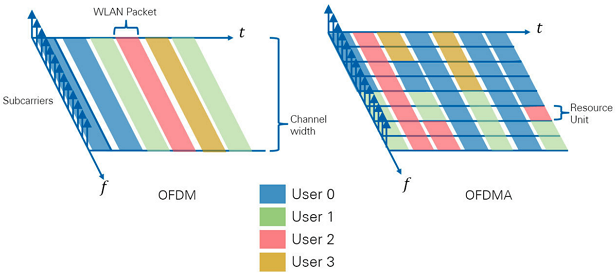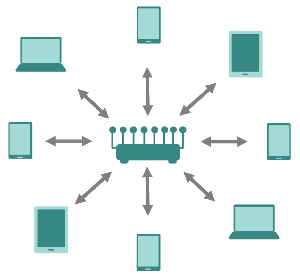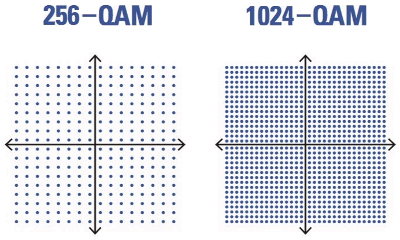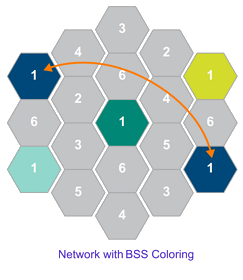What you need to know about Wi-Fi 6 (IEEE 802.11ax)
In 2018, the Wi-Fi Alliance group announced Wi-Fi 6 - a new Wi-Fi standard based on IEEE 802.11ax technology. New simplified names for current and future Wi-Fi standards were introduced (we have an article on that: New names for Wi-Fi standards). The Wi-Fi 6 certification program began in September 2019, and the IEEE standards association officially adopted (ratified) it in September 2020. In 2021, Keenetic released the first router model supporting the Wi-Fi 6 class.
In general, IEEE 802.11ax is based on the modern, current 802.11ac standard (Wi-Fi 5) and uses existing technologies. According to the standard developers, some new technologies will be useful when deploying high-density Wi-Fi networks. Certain solutions will improve the quality of communication in places with high network load and in conditions of high radio traffic occupancy (for example, in public transport, shopping centres, hotels, stadiums or corporate networks). The tangible result of the transition to 802.11ax will be visible only if all devices in the network support the new standard.
The benefits of the Wi-Fi 6 standard will not dramatically affect home users. A Wi-Fi router with 802.11ax support will not become more powerful than 802.11ac, and the signal coverage will not increase. The connection speed of devices without 802.11ax support will not increase.
A single Wi-Fi 6 router is still unable to replace a Wi-Fi system and cover a multi-room or multi-level room with solid walls and ceilings without significant speed loss. Using multiple access points without customer support for the new OFDMA and UL MU-MIMO technologies will have a much greater effect.
If you already have client devices supporting 802.11ax or if you are planning to buy the latest router supporting the latest Wi-Fi 6 standard 'for the future', taking into account the pace of development of new technologies and gadgets, with the prospect of updating W-Fi devices in the network, the choice of Keenetic router supporting Wi-Fi 6 standard will be the best solution. But even today, in many cases, the practical and best option for connecting to the Internet, and organizing your own Wi-Fi network, is to use a dual-band 802.11ac Wi-Fi router and 802.11ac-enabled mobile devices. In this case, you'll also get the benefits of dual-band networks and fast Wi-Fi data speeds. Keenetic's older flagship Wi-Fi 5 models (Titan, Giant) are almost as good as the new 802.11ax-enabled models in performance.
The new standard Wi-Fi 6 certainly has some useful innovations and is the next stage in developing network technologies. But the transition from Wi-Fi 5 to Wi-Fi 6 does not look like a breakthrough and significant for users, as was the transition from Wi-Fi 4 (802.11n) to Wi-Fi 5 (802.11ac). The 802.11ac standard allowed users to use the free 5 GHz frequency band, multiple times the data rate, by increasing channel widths and introducing new Airtime Fairness and Beamforming technologies. Over time, as users upgrade their devices, they can expect to benefit from the new technologies of the Wi-Fi 6 standard, the adaptation and implementation of which is just beginning.
Please note that it is not possible to software upgrade Keenetic Wi-Fi 5 models to Wi-Fi 6.
Below you can learn about the main innovations of the standard Wi-Fi 6 (IEEE 802.11ax).
Increasing the nominal physical data rate
Overall, data transfer speeds in Wi-Fi 6 are not significantly higher than in Wi-Fi 5.
In Wi-Fi 6, the maximum theoretical data rates can be 600 Mbps (80 MHz, 1 spatial stream) and 9607 Mbps (160 MHz, 8 spatial streams), instead of 433 Mbps (80 MHz, 1 spatial stream) and 6933 Mbps (160 MHz, 8 spatial streams) in the Wi-Fi 5 standard.
Some unscrupulous manufacturers on their boxes and marketing flyers claim more than double the speed increase in 802.11ax, based on the use of 160 MHz channels, which are also available in 802.11ac (for example, in Keenetic Titan KN-1810), but are rarely used due to spectrum limitations*. 802.11ax will not avoid these limitations either.
* — The 160 MHz channel width uses eight standard 20 MHz channels at once. This mode occupies twice the frequency range, which for some devices that do not support an extensive set of channels, leads to the fact that it will be impossible to organize non-intersecting networks on the air. The 160 MHz channels are, in reality, only relevant for customers who have their support and work in the pure 5 GHz radio air.
For more information, refer to the article Available channels on the 5 GHz Wireless network.
OFDMA mode
Wi-Fi 6 adds OFDMA mode (Orthogonal Frequency Division Multiple Access) to improve spectral efficiency. OFDMA technology has been borrowed from the 4G LTE cellular industry and is similar to the multiuser version of OFDM used in Wi-Fi 5.
OFDMA provides the ability to establish connections between an access point and multiple clients simultaneously by dividing the signal into subcarriers (additional smaller subchannels) and separating them into groups for processing separate data streams, called Resource Units (RU). It will allow multiple Wi-Fi 6 clients to simultaneously broadcast data at an average rate and use the same channel instead of waiting.
To take advantage of this improvement, all clients must necessarily support the 802.11ax standard. The effect is completely unnoticeable with a small number of devices and a heavy workload of the access point.

Improved MU-MIMO technology
Wi-Fi 6 provides uplink support for MU-MIMO (UL Multi-User Multiple-Input, Multiple-Output) technology. Previously in Wi-Fi 5, MU-MIMO only worked downstream from router to client (DL MIMO).
It is assumed that Wi-Fi 6 can theoretically support simultaneous transmission of up to 8 spatial streams in both directions (8x8), with the ability to deliver four simultaneous streams to a single client. But this functionality may not be supported in early versions of 802.11ax certified equipment. Mass devices will mainly use MIMO 4x4 and 2x2.
The Wi-Fi Alliance says that DL MU-MIMO and OFDMA mode will improve network load capacity and performance by providing more simultaneous connections and better utilising the allocated band. But this will only work if the clients support these technologies. Right now, most clients do not even support MU-MIMO and the 802.11ac second version of Wave2. And those clients that do will still not have support for bi-directional MU-MIMO.

Increase modulation level to 1024-QAM
1024-QAM increases the length of each coding character from 8 bits (in 256-QAM on Wi-Fi 5) to 10 bits, which improves transmission speed and spectrum efficiency by around 25% because more data will be placed in each packet.
But note that this improvement only works in conditions where signal strength is high and noise is low. For example, the level of signal receiving power required to decode a 1024-QAM 5/6 modulation frame for an 80 MHz channel must be at least -45 dBm, and this can only be achieved when the receiver and transmitter are close to each other.

Below is a table of the maximum supported data rates (in Mbps) for 802.11ax, depending on the number of Spatial Streams, Modulation, Coding rate, Channel width (20/40/80/160 MHz) and Guard Interval.

Using the BSS Color network packet colouring mechanism
In Wi-Fi 6, wireless devices will be able to identify signals from overlapping BSS (Basic Service Set) networks and prevent conflicting situations based on this information. To distinguish packets from different BSSs, the standard introduced a new concept of 'colour' identifier — Color Code.
If wireless devices are operating on the same channel, they can transmit in an 802.11ax frame with a unique Color Code BSS. If the identifiers match, they can exchange data over the air simultaneously, without waiting. If the detected frame has a different Color Code BSS ID, the device will ignore it. The BSS Color mechanism performs packet marking on the channels to recognise 'friend or foe'. Until recently, there was no mechanism for identifying the network packet by the 'friend or foe' type, and if some device transmits on the air, others are waiting their turn. This caused some drop in transmission speed and increased waiting time in networks with many devices.
Again, please note that for the BSS Color mechanism to work, the wireless devices on your network must support the Wi-Fi 6 standard.

Lower power consumption
Existing power saving modes have been supplemented with new mechanisms. Target Wake-up Time (TWT, target wake-up time or wake on demand), developed in 802.11ah protocol, has been added. It will allow client devices with Wi-Fi 6 support to sleep and "wake up" on a schedule. The router can tell the client when to 'sleep' and when to 'wake up', which is expected to save battery power, increase standby battery life and reduce network congestion.
Outdoor work
Some new features in the Wi-Fi 6 standard improve performance in outdoor environments. Most importantly, the new packet format, in which the most sensitive field is now repeated for reliability, and longer guard intervals provide redundancy for error correction.
A description of the features and characteristics of Wi-Fi 6 can be found in an official document from the Wi-Fi Alliance Wi-Fi_6_White_Paper_20181003.pdf or by following the links: